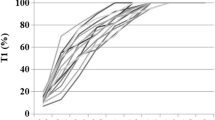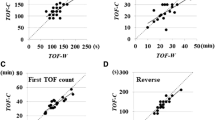Abstract
Purpose
The main aim of this study was to compare the onset times of rocuronium evaluated subjectively and by acceleromyography at the masseter muscle (MM).
Methods
Forty female patients were sequentially enrolled in this study. In the first 20 patients, neuromuscular block was evaluated subjectively. After induction of anesthesia with fentanyl and propofol, both the left masseter and ulnar nerves were stimulated in 2-Hz train-of-four (TOF) mode using peripheral nerve stimulators. Contractions of the MM were felt with an anesthesiologist’s left hand holding an anesthesia facemask; those of the adductor pollicis (APM) were visually observed. All the patients received a bolus of rocuronium, 0.6 mg/kg. Onset times after rocuronium were defined as the duration until the contractions became impalpable at the MM or invisible at the APM. At the time contraction of the MM had not been felt, intubating conditions were assessed. In the next 20 patients, contractions of the MM and the APM were concurrently quantified using acceleromyography after induction of anesthesia and laryngeal mask insertion. Following 0.6 mg/kg rocuronium, onset of the action was recorded.
Results
Onset of the action of rocuronium at the MM evaluated subjectively [mean (SD), 70.3 (17.7) s] was similar to that monitored acceleromyographically [73.3 (27.6) s, P > 0.05], and significantly shorter than that at the APM acceleromyographically [111.0 (34.8) s, P = 0.016]. Intubating conditions of 20 patients were graded either excellent or good.
Conclusion
Subjective evaluation of contractions of the MM by an anesthesiologist’s hand may be reliable to determine faster timing for safe tracheal intubation.

Similar content being viewed by others
References
Meistelman C, Plaud B, Donati F. Rocuronium (ORG 9426) neuromuscular blockade at the adductor muscles of the larynx and adductor pollicis in humans. Can J Anaesth. 1992;39:665–9.
Cantineau JP, Porte F, d’Honneur G, Duvaldestin P. Neuromuscular effects of rocuronium on the diaphragm and adductor pollicis muscles in anesthetized patients. Anesthesiology. 1994;81:585–90.
De Mey JC, De Baerdemaeker L, De Latt M, Rolly G. The onset of neuromuscular block at the masseter muscle as a predictor of optimal intubating conditions with rocuronium. Eur J Anaesth. 1999;16:387–9.
de Rossi L, Preußler NP, Pühringer FK, Klein U. Onset of neuromuscular block at the masseter and adductor pollicis muscles following rocuronium or succinylcholine. Can J Anaesth. 1999;46:1133–7.
Kitajima O, Suzuki T, Watanabe N, Maeda T, Noda Y, Saeki S, Ogawa S. Monitoring masseter muscle evoked responses enables faster tracheal intubation. J Anesth. 2010;24:173–6.
Hemmerling TM, Donati F. Neuromuscular blockade at the larynx, the diaphragm and the corrugator supercilli muscle: a review. Can J Anaesth. 2003;50:779–94.
Fuchs-Buder T, Claudius C, Skovgaard LT, Eriksson LI, Mirakhur RK, Viby-Mogensen J. Good clinical research practice in pharmacodynamic studies of neuromuscular blocking agents II: the Stockholm revision. Acta Anaesthesiol Scand. 2007;51:789–808.
Suzuki T, Fukano N, Kitajima O, Saeki S, Ogawa S. Normalization of acceleromyographic train-of-four ratio by baseline value for detecting residual neuromuscular block. Br J Anaesth. 2006;96:44–7.
Meretoja OA, Taivainen T, Brandom BW, Wirtavuori K. Frequency of train-of-four stimulation influences neuromuscular responses. Br J Anaesth. 1994;72:686–7.
Plaud B, Proost JH, Wierda MKH, Barre J, Debaene B, Meistelman C. Pharmacokinetics and pharmacodynamics of rocuronium at the vocal cords and the adductor pollicis in humans. Clin Pharmacol Ther. 1995;58:185–91.
Bragg P, Fisher DM, Shi J, Donati F, Meistelman C, Lau M, Sheiner LB. Comparison of twitch depression of the adductor pollicis and the respiratory muscles. Pharmacodynamic modeling without plasma concentrations. Anesthesiology. 1994;80:310–9.
Acknowledgments
This study was funded by the Department of Anesthesiology, Surugadai Nihon University Hospital, Tokyo, Japan.
Conflict of interest
There are no relationships between authors and any company or organization with a vested interest in the outcome of the study.
Author information
Authors and Affiliations
Corresponding author
About this article
Cite this article
Kitajima, O., Suzuki, T., Fukano, N. et al. Onset of rocuronium-induced neuromuscular block evaluated subjectively and accerelomyographically at the masseter muscle. J Anesth 25, 376–379 (2011). https://doi.org/10.1007/s00540-011-1129-0
Received:
Accepted:
Published:
Issue Date:
DOI: https://doi.org/10.1007/s00540-011-1129-0




